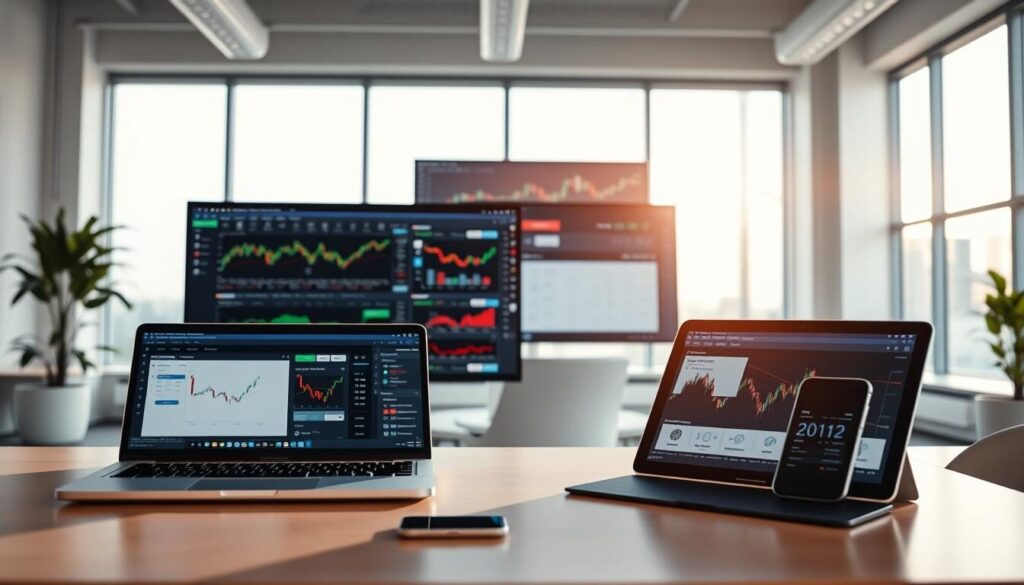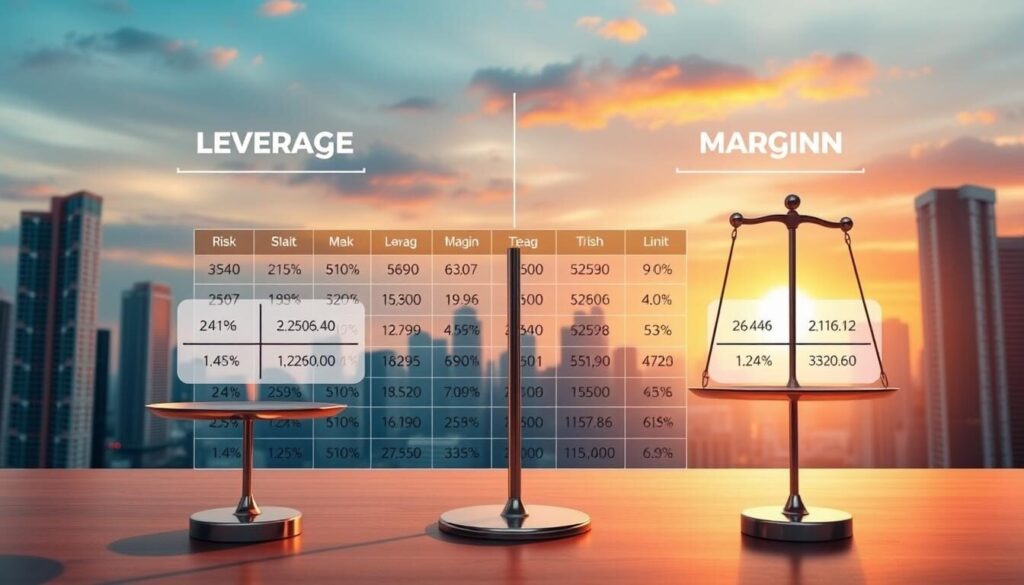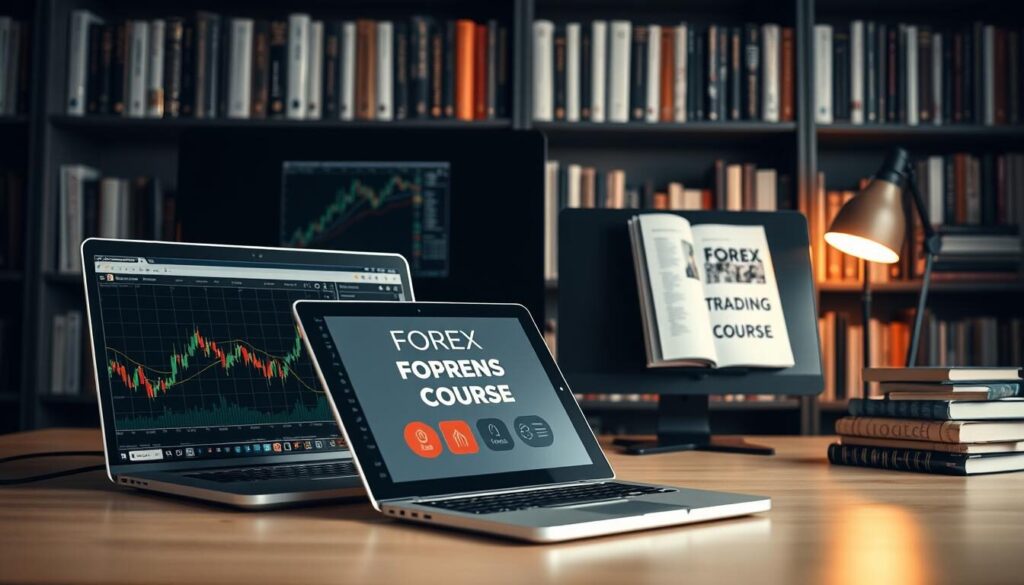Let’s get real: picking your first forex broker is like choosing a parachute. You want one that won’t snap mid-air. A forex broker isn’t just a middleman—they’re your lifeline to the $7.5 trillion currency market. Think of them as the GPS for your money’s global road trip.
We’ve all bought shoes that looked cool but murdered our feet. Same logic applies here. A bad broker? Slippery fees. Unreliable platforms. Suddenly your “get-rich” plan feels like running a marathon in flip-flops.
This guide’s your shortcut. We’ll break down how regulated brokers (like IG or eToro) keep your cash safe in segregated accounts. Why learning tools matter more than flashy ads. And how to spot brokers offering 80+ currency pairs without drowning you in complexity.
Key Takeaways
- Forex brokers act as your gateway to buying/selling currencies—no physical cash required
- Regulation (like FCA oversight) is non-negotiable for fund safety
- Top brokers offer crash courses—IG Academy’s basically Trading 101 in your pajamas
- User-friendly platforms turn “Wait, how do I?” moments into confident clicks
- We’re covering trust scores, hidden fees, and why spreads matter more than you think
Introduction to Forex Trading for Beginners
Picture this: Your phone buzzes at 3 AM with a currency swing opportunity. Welcome to forex trading – where Tokyo sleeps while New York trades against London’s lunch break. This $7.5 trillion playground never closes (except weekends), letting you swap euros for yen while sipping midnight coffee.
Think of currency pairs like airport currency exchanges on steroids. EUR/USD? That’s the euro’s value measured in dollars. Each pair dances to its own beat – major ones (think GBP/USD) move predictably, while exotic combos (USD/TRY?) swing like Tarzan on espresso.
| Pair Type | Examples | Liquidity |
|---|---|---|
| Major | EUR/USD, USD/JPY | Highway smooth |
| Minor | GBP/CAD, AUD/NZD | City traffic |
| Exotic | USD/THB, EUR/TRY | Off-road adventure |
Here’s where forex brokers become your co-pilot. They’re not just order-takers – they’re your leverage providers (hello, 30:1 power boosts), margin calculators, and CFD wizards. But choose wrong, and hidden fees will nibble your profits like airport ATM charges.
Demo accounts are your training wheels. IG’s practice platform lets you crash virtual trades without burning real cash. Pro tip: Treat it like dating – test multiple brokers before committing. After all, you wouldn’t marry someone based on their Tinder profile.
Remember the 2008 yen surge? Traders with tight spreads rode the wave. Those with slippery brokers? Wiped out faster than a tourist using “currency exchange” kiosks. Your broker choice isn’t just about tools – it’s financial survival.
Understanding Forex Brokers
Imagine your broker as the backstage crew at a concert – invisible but essential. They’re your bridge to the forex market, handling the techy stuff while you focus on hitting the right trading notes. Without them, you’re just shouting song requests into the void.
What’s a Forex Broker?
Think of them as your currency concierge. When you trade euros for yen, they’re the ones whispering, “Got your back” while connecting you to global markets. Unlike stockbrokers, they specialize in pairing currencies like a sommelier matches wine with cheese – except here, the cheese might be Turkish lira.
Broker Types Decoded
Not all brokers play the same game:
- Market Makers: The convenience stores of forex. They set prices themselves (like charging $1.50 for a $1 water bottle) and take the opposite side of your trade
- STP Brokers: Your direct flight to liquidity providers. No middleman – just you and the real market prices
- ECN Brokers: The stock exchange of currency trading. They auto-match buyers/sellers like Tinder for dollars and euros
- DMA Brokers: VIP access to interbank rates. Perfect for traders who want to negotiate prices like they’re haggling at a Moroccan souk
Your trading platform is the steering wheel here. MetaTrader 4? That’s the Honda Civic of platforms – reliable, everywhere. Fancy tools like AutoChartist? Your GPS for spotting market patterns.
And about customer support – ever tried explaining a tech issue to someone who speaks “manual script”? Quality brokers offer live chat that actually helps, not chatbots stuck in 2012. Pro tip: Test their support during off-hours. If they respond faster than your Uber Eats driver, you’re golden.
The Importance of Regulatory Compliance in Forex Trading
Ever wonder why some traders sleep soundly while others check their accounts hourly? The difference often boils down to one word: regulation. Think of it as the seatbelt for your trading journey – you hope you’ll never need it, but you’d never drive without it.
Why Regulation Matters
Regulatory bodies like the FCA and ASIC act as financial referees. They ensure brokers play fair – no hidden fees, no funny business with your funds. IG Group, for instance, keeps client money in segregated accounts. That means your cash isn’t mixed with the company’s operating funds, even if they hit financial turbulence.
| Regulator | Region | Key Protection |
|---|---|---|
| FCA | UK | £85k compensation scheme |
| ASIC | Australia | Daily reconciliation checks |
| CySEC | EU | Negative balance protection |
| NFA/CFTC | USA | Segregated accounts requirement |
Here’s the kicker: regulated brokers undergo regular audits. It’s like having a nutritionist inspect your meal prep – everything must meet strict standards. This transparency builds trust, letting you focus on trading strategies instead of security nightmares.
New to the game? Regulated trading platforms often offer demo accounts – virtual playgrounds where mistakes don’t cost real money. These practice zones let forex traders test strategies risk-free, like rehearsing a concert in an empty stadium before the big show.
Remember the 2015 Swiss franc shock? Traders with regulated brokers got lifeboats. Others? They learned why swimming with sharks without a cage is a bad idea. Regulation won’t guarantee profits, but it ensures the game isn’t rigged against you from the start.
Comparing Trading Platforms and Tools

Clunky tools ruin the mission. Trading platforms either become your secret weapon or that drawer full of useless kitchen gadgets. Think of MetaTrader 4 as your reliable multi-tool – 15 million traders can’t be wrong. But OANDA’s custom charts? That’s the sous vide machine serious chefs add to their arsenal.
Training Wheels That Don’t Scrape Your Knees
Demo accounts are dating apps for platforms – swipe right on multiple options before committing. FOREX.com’s practice mode lets you test strategies using fake cash, like rehearsing karaoke in the shower. Pro tip: Treat virtual trades as seriously as real ones. Would you belt out Whitney Houston half-heartedly?
| Platform | Best For | Unique Feature |
|---|---|---|
| MetaTrader 4 | Automated trading | 1-click trading bots |
| cTrader | Speed demons | Real-time market depth |
| TradingView | Chart addicts | Social trading charts |
When Stock Android Just Won’t Cut It
Third-party integrations turn basic platforms into powerhouses. Capitalise.ai’s automation? Set trading rules like “Buy if Bitcoin sneezes.” TradingView’s social charts let you stalk top performers’ moves – the financial equivalent of peeking at the chef’s notepad.
Risk management tools act as airbags. Platforms like NinjaTrader let you set stop-loss orders that trigger faster than a cat avoiding bath time. Start trading with these safeguards, and you’ll sleep better than traders relying on “gut feelings” and caffeine.
Evaluating Spreads, Fees, and Commission Structures
Trading without understanding costs is like buying coffee at the airport – you’ll pay triple without realizing why. Spreads, fees, and commissions nibble at profits like seagulls stealing fries. Let’s break down these silent budget killers.
Spreads are the price of admission. Imagine buying concert tickets where the seller adds a “convenience fee” – that’s the difference between bid and ask prices. For EUR/USD, a 1.5 pip spread means paying $15 extra per $100,000 traded. Variable spreads? They’re like Uber surge pricing during market chaos.
| Broker Type | EUR/USD Spread | Commission per Lot |
|---|---|---|
| Commission-Free | 1.8 pips | $0 |
| Raw Spread | 0.2 pips | $3.50 |
Here’s the math: Trading 10 lots monthly? A 1-pip difference saves $100 – enough for three streaming subscriptions. Brokers with transparent fee schedules list costs like nutrition labels. Hidden fees? Those are the crumbs left after the cookie monster visits.
Three cost traps to avoid:
- Swap fees that charge you for holding positions overnight
- Inactivity penalties hitting after 90 days (looking at you, $10 monthly fee)
- “Free” platforms with spreads wider than a yoga mat
Demo accounts reveal true costs. Test brokers like sampling sneakers – walk a mile in their spreads before committing. Because in trading, pennies add up faster than likes on a cat video.
Assessing Leverage, Margin, and Risk Management Options

Leverage in forex is like using a power drill – it magnifies your force, but one wrong move and you’re drilling through the wall. Here’s the deal: brokers let you control $100,000 trades with just $1,000. Sounds sweet until the market swings 2% against you. That’s when margin calls hit like a bounced check.
Power Tools for Your Wallet
Leverage ratios determine how much borrowed cash you’re playing with. Think 30:1 means every dollar becomes thirty. Margin? That’s your skin in the game – the minimum deposit to keep trades open. Pro tip: Start with 10:1 leverage. It’s training wheels mode for new traders.
| Currency Pair | Margin Requirement | Leverage Ratio |
|---|---|---|
| EUR/USD | 2% | 50:1 |
| USD/JPY | 3% | 33:1 |
| USD/TRY | 20% | 5:1 |
Your Financial Airbag
Negative balance protection works like a circuit breaker. When markets crash harder than a TikTok trend, this feature stops losses at zero. No owing the broker $5k because your exotic currency bet imploded. Regulated platforms like eToro auto-close positions before you’re underwater.
Three rules for surviving leverage:
- Calculate margin needs before trading – math isn’t optional
- Set stop-loss orders tighter than your gym shorts
- Treat high leverage like hot sauce – a little goes a long way
Remember the 2020 oil price nosedive? Traders using 500:1 leverage got margin called faster than you can say “risk management.” Your broker’s tools are only as good as your discipline to use them.
How to Choose the Best Forex Broker for Beginners
Finding your first forex broker feels like speed-dating 20 potential matches. IG’s demo account lets you swipe right risk-free, while Pepperstone’s razor-thin spreads whisper sweet nothings to scalpers. But which one deserves your trading loyalty?
- FCA or ASIC regulation – your money’s seatbelt
- Platforms smoother than a fresh jar of Skippy
- Demo modes that don’t expire faster than milk
| Broker | Regulation | Minimum Deposit | Perks |
|---|---|---|---|
| IG | FCA | $250 | 90+ currency pairs |
| AvaTrade | ASIC | $100 | 24/5 support |
| Pepperstone | FCA | $200 | cTrader access |
Day traders? Pepperstone’s 0.0 pip spreads will sing. Long-term players? IG’s research tools act like a crystal ball. Test their platforms like dating profiles – does their mobile app crash more than your college website?
Pro move: Open three demo accounts simultaneously. Compare execution speeds during London/New York overlap. Notice which broker’s charts update faster than TikTok trends. Your gut will pick the winner before your brain does.
Remember – the “perfect” broker doesn’t exist. It’s about whose flaws you can tolerate at 3 AM when the yen starts dancing. Now go play the field – your trading soulmate awaits.
The Role of Customer Support in Forex Trading

Think of customer support as your trading safety net. When currency markets move faster than a TikTok dance trend, you need help that arrives before FOMO turns into OH-NO. Quality assistance isn’t just nice-to-have – it’s your first line of defense against costly mistakes.
Available Contact Channels
Top brokers offer support options smoother than a fresh jar of Skippy. Live chat? It should connect faster than your Uber driver cancels. Phone support? Available when Tokyo traders are eating midnight ramen. Here’s what matters:
| Channel | Response Time | Best For |
|---|---|---|
| Live Chat | Urgent trade issues | |
| 2-4 hours | Documentation requests | |
| Social Media | 1 hour | General inquiries |
Pro tip: Test their off-hours response during London/New York market overlap. If they reply slower than dial-up internet, keep shopping.
Support Tailored for New Traders
Beginner-friendly brokers act like patient tour guides. They explain risk management tools without making you feel dumb. Look for:
- Step-by-step video tutorials (think “Currency Pairs for Dummies”)
- Dedicated account managers for hand-holding
- Demo account troubleshooting sessions
Brokers with high-quality customer service often provide 24/5 support – crucial when you’re sweating a midnight trade. Remember: Clear communication prevents more losses than any stop-loss order.
Your takeaway? Customer support shouldn’t be an afterthought. It’s the difference between navigating stormy markets confidently and drowning in spreadsheet confusion.
Trading Hours and Market Accessibility
The forex market never sleeps – it’s like a global relay race where Tokyo hands the baton to London, then New York takes over. This 24/5 marathon means you can trade EUR/USD at breakfast or USD/JPY during insomnia hours. But timing isn’t just about convenience – it’s where pairs come alive.
| Session | Cities | UTC Hours | Active Pairs |
|---|---|---|---|
| Asian | Tokyo/Sydney | 23:00-08:00 | USD/JPY, AUD/NZD |
| London | UK/Europe | 07:00-16:00 | EUR/GBP, GBP/USD |
| New York | US/Canada | 12:00-20:00 | USD/CAD, EUR/USD |
Night owls rejoice – Sydney’s session starts when New Yorkers are ordering midnight pizza. Brokers with weekend support let you trade major pairs like GBP/USD even on Saturdays. But remember: liquidity thins faster than hair at a tech conference during off-peak hours.
Platform tools act as market alarm clocks. Set alerts for London opens or Tokyo closes – like having a personal assistant nudge you when volatility spikes. Pro tip: Match sessions to your circadian rhythm. If you’re sharper before coffee, catch the Asian session’s calm waters.
Accessibility equals opportunity. A nurse working night shifts could profit from New York closes. A Tokyo salaryman might scalp EUR/JPY during lunch breaks. Your broker’s hours shouldn’t box you in – they should open doors to global markets, one time zone at a time.
Account Funding and Withdrawal Processes
Moving money should feel like sliding into DMs – quick, painless, and without awkward fees. Smooth transactions keep your trading rhythm intact, whether you’re topping up for a hot streak or cashing out profits.
Deposit Methods and Funding Options
Brokers roll out the red carpet for your cash. Bank transfers? Reliable but slower than snail mail. Cards and e-wallets? Instant deposits – like Venmo-ing your account while waiting for coffee. Here’s the menu:
| Method | Speed | Fees |
|---|---|---|
| Credit/Debit Card | Instant | 0-2% |
| Bank Transfer | 1-3 days | $10-25 |
| Wise/PayPal | Instant | 1.5% |
Newer platforms even accept crypto. Depositing Bitcoin feels like using arcade tokens – except these tokens could buy a Lamborghini. Minimum deposits range from $10 (micro accounts) to $500 (premium tiers).
Smooth Withdrawal Procedures
Cashing out shouldn’t feel like escaping Alcatraz. Top brokers process withdrawals faster than you can say “Where’s my money?” E-wallets? Often same-day. Bank transfers? 2-5 business days – perfect for practicing patience.
Watch for conversion fees. Withdrawing euros to a USD account? That’s like paying for guac twice – some brokers charge extra. Always check:
- Hidden withdrawal fees (looking at you, 3% “processing” charges)
- Weekend processing delays
- Minimum withdrawal amounts
Pro tip: Test withdrawals with small amounts first. It’s like dipping toes before cannonballing – ensures the pool’s actually filled.
Navigating a Wide Range of Currency Pairs and Markets
Currency pairs are like a global buffet – too many options can overwhelm, but the right mix satisfies every trading appetite. Brokers dish out 80+ pairs alongside stocks and crypto, turning your portfolio into a diversified feast. Majors like EUR/USD? That’s the mashed potatoes – predictable and comforting. Exotics like USD/ZAR? The ghost pepper wings – thrilling but risky.
| Pair Type | Examples | Typical Spread | Volatility |
|---|---|---|---|
| Majors | EUR/USD, USD/JPY | 0.8 pips | Calm waves |
| Minors | AUD/CAD, NZD/SGD | 2.1 pips | Rippling creek |
| Exotics | USD/THB, EUR/TRY | 15 pips | Tsunami mode |
Time your trades like a mic drop. London session? Majors move smoother than a jazz saxophonist. Asian hours? Exotics might twerk unexpectedly. Brokers with tight spreads on minor pairs become your backstage pass – saving fees adds up faster than TikTok followers.
Why care? During the 2020 oil crash, USD/CAD swung 8% in a week – traders with low-fee access rode the rollercoaster profitably. Emerging markets like MXN/JPY? They’re the surprise guest stars – volatile but potentially show-stopping.
Your playbook:
- Use majors for steady gains – your 9-to-5 grinders
- Experiment with exotics using demo accounts first
- Compare brokers’ fees like menu prices – hidden charges ruin the meal
Customer service matters when markets get spicy. Imagine needing help during a Turkish lira meltdown – you want live chat, not an FAQ graveyard. The right broker serves markets like a five-star chef – diverse, fresh, and worth every penny.
Leveraging Educational Tools and Demo Accounts

Mastering forex is like learning guitar – you need the right lessons before your first gig. Brokers now serve up free educational resources that turn confusion into clarity. IG Academy’s video tutorials? Think Netflix for trading – binge-worthy content that actually pays off.
Free Educational Resources
Top brokers roll out learning options like a buffet. Webinars dissect market trends like true crime podcasts. Interactive quizzes test your skills – it’s trading meets trivia night. FP Markets dishes out eBooks so detailed, they’d make Wikipedia jealous.
Demo accounts are your financial flight simulator. AvaTrade’s $100k virtual balance lets you crash trades without burning cash. Pepperstone’s 30-day trial? Perfect for testing strategies faster than TikTok trends fade.
| Broker | Learning Tools | Demo Perks |
|---|---|---|
| IG | Live Trading Sessions | 90-Day Access |
| eToro | Social Trading Challenges | $100k Virtual Cash |
| AvaTrade | Risk Management Courses | Unlimited Resets |
New traders often panic like squirrels in traffic. Demo experience changes that. One client turned $20k fake money into $150k virtual profits – then replicated it live. Practice builds muscle memory, turning shaky clicks into confident trades.
Platforms like MetaTrader 4 come with training wheels. Built-in charts explain patterns better than a trigonometry tutor. Pro tip: Treat demo trading like dress rehearsals – the stakes feel real, but the curtain call won’t bankrupt you.
Developing a Robust Trading Strategy
A trading strategy without structure is like driving cross-country without GPS – you’ll eventually arrive, but the detours will cost you. Your plan needs more precision than a barista’s espresso shot measurements. Start by defining your risk appetite: Are you the skydiving type or more “two-feet-on-the-ground”?
Your Financial Playbook
Alerts and stop-loss orders are your trading seatbelts. Set price notifications tighter than your gym shorts – they’ll ping you when leverage starts flirting with danger zones. Here’s the breakdown:
| Tool | Function | Real-World Example |
|---|---|---|
| Entry Alert | Flags ideal buy/sell points | EUR/USD hits 1.0850 |
| Stop-Loss | Automatic exit at set loss | Limits downside to 2% |
| Take Profit | Locks gains automatically | Closes trade at 5% profit |
Platforms like MetaTrader 4 turn strategy execution into tapas – small, manageable bites. One trader shared:
“My stop-loss saved 30% of my money during the 2022 pound crash. It hurt, but bankruptcy hurts more.”
Leverage isn’t a free money glitch. Using 50:1 leverage on volatile pairs? That’s juggling chainsaws – thrilling until it isn’t. Allocate no more than 1-2% of capital per trade. Your account isn’t a Vegas buffet.
Back-test strategies like rehearsing Shakespeare. Demo accounts let you bomb virtual trades without audience boos. Pepperstone’s 90-day trial gives access to historical data – perfect for spotting patterns faster than TikTok detectives.
Adjust tactics like a DJ mixing tracks. Markets shift moods quicker than a teenager’s playlist. Track performance metrics religiously. If your win rate drops below 45%, it’s time to remix your approach.
Advanced Tools and Technology for Active Traders

Think of modern trading platforms as a Michelin-star kitchen – every tool serves a purpose. MetaTrader 5’s 38+ indicators act like precision knives, while eToro’s CopyTrader functions as your sous chef. These services turn complex analysis into tapas-sized tasks.
Algorithmic trading lets you set rules like “Buy if GBP/USD dips below 1.26” – then walk away. One trader shared:
“My bots handle night shifts better than caffeine ever could.”
Mobile apps and desktop platforms sync smoother than AirPods. Update stop-loss orders during your commute, then analyze currencies on a 4K monitor at home. Brokers like Interactive Pro offer:
| Platform | Speed | Specialty |
|---|---|---|
| MT5 | 0.4s execution | Depth of Market |
| cTrader | 0.2s execution | 100+ order types |
| NinjaTrader | Custom scripts | Backtesting suite |
Social trading turns markets into team sports. Mirror top performers’ moves like streaming a workout class – but for profit. Demo accounts let you test strategies risk-free. One user turned $50k virtual cash into $320k using MT4’s pattern recognition.
Advanced tools demand practice. Spend hours in demo mode like a pilot in a flight simulator. The learning curve? Steeper than a skateboard ramp. But master these services, and you’ll trade multiple currencies with spreadsheet-level precision.
Exploring Future Trends in Forex Trading
The forex market’s future looks brighter than a SpaceX launchpad. Blockchain isn’t just for crypto bros anymore – brokers like Pepperstone now use it to verify trades faster than you can say “decentralized ledger.” Imagine transaction records that can’t be altered – like carving your trades in digital diamond.
AI tools are evolving into caffeine-fueled analysts. eToro’s Smart Portfolios now scan 8,000 data points hourly – spotting patterns human eyes miss. One trader joked:
“It’s like having Warren Buffett’s brain plugged into ChatGPT.”
Regulators are tightening screws while greasing innovation wheels. The FCA’s new algo-trading rules act like seatbelts for AI-driven strategies. Meanwhile, ASIC pushes for fee transparency – goodbye to hidden charges lurking like ninjas in your account statements.
| Current Tools | Future Upgrades | Impact |
|---|---|---|
| Basic Charts | 3D Market Maps | See volatility hotspots |
| Email Alerts | VR Trade Rooms | Collaborate globally |
| Demo Accounts | AI Strategy Sandboxes | Test 100 scenarios in minutes |
Platforms are ditching clunky interfaces for TikTok-simple designs. Think swipe-left rejections on bad trades or emoji reactions to market moves. AvaTrade’s beta app lets users voice-command trades – “Sell EUR when Bitcoin hits $70k” actually works.
Savvy traders treat these changes like software updates – install early, avoid crashes. Your strategy needs blockchain’s security and AI’s brainpower. Update your accounts to brokers blending innovation with regulation. The future’s knocking – will your trading plan answer?
Conclusion
Your trading journey starts with one solid foundation – the broker you trust. Like building a house, every choice matters: regulation acts as your earthquake-proof base, tight spreads keep walls sturdy, and demo accounts let you test-drive the blueprint risk-free.
Key takeaways? Prioritize FCA or ASIC oversight – your financial seatbelt. Compare costs like a bargain hunter at a flea market. Platforms should feel as intuitive as your favorite app, with tools that turn confusion into clarity. And always pack risk management – it’s the flashlight for market blackouts.
Ready to dive in? Test brokers like sampling sneakers – walk a mile in their CFDs and mobile apps before buying. eToro’s virtual portfolio lets you crash-trade without burning cash. Pepperstone’s razor spreads sharpen your edge. Remember: every pro started with shaky clicks and demo drills.
This guide’s your launchpad, not the destination. Markets evolve faster than TikTok trends, so keep learning. Bookmark IG’s webinars. Follow FX Leaders’ updates. Treat each trade as practice for the big leagues.
Now’s your moment. With the right broker as co-pilot, those currency charts transform from hieroglyphics to roadmaps. Start small. Stay curious. Your first confident click could be the spark that lights a lifelong trading fire.
